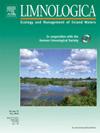The early colonisation of experimental mesocosms: The role of active and passive dispersal mode
IF 2
4区 环境科学与生态学
Q2 LIMNOLOGY
引用次数: 0
Abstract
Ephemeral wetlands represented a special type of periodic waters that are often found in intensively agriculturally managed landscapes. This study demonstrates the influence of both soil addition and the presence of Daphnia magna competitor on the development of invertebrate communities in experimental mesocosms. Treatments included rainwater-filled mesocosms with and without the addition of Daphnia magna, and with and without the addition as arable soil serving as a potential egg bank source. The early colonisation was monitored by two subsequent sampling periods with a total exposition time of 42 days. We hypothesised that factors potentially influencing emerging species communities may include the presence and absence of D. magna as a community engineer, as well as the presence and absence of soil fraction. The results showed that the addition of arable soil significantly influenced physico-chemical parameters, increasing conductivity and total nitrogen. Rotifers were the first colonisers, with a higher abundance in treatments with added soil. D. magna survived and established populations only in treatment with added arable soil but did not survive in rainwater only treatment. Chironomids were the most diverse group, with increased abundance and taxa richness over time. The presence of D. magna in the soil-amended treatment resulted in a unique community structure, likely due to its grazing impact on the food web.
实验中生态系统的早期殖民化:主动和被动扩散模式的作用
短暂湿地是一种特殊类型的周期性水域,通常出现在集约化农业管理的景观中。本研究探讨了土壤添加和大水蚤的存在对实验中生态系统无脊椎动物群落发育的影响。处理包括添加和不添加水蚤的充满雨水的中生态系统,以及添加和不添加水蚤作为潜在卵库来源的耕地土壤。早期的定植通过随后的两次采样来监测,总暴露时间为42天。我们假设潜在影响新兴物种群落的因素可能包括作为群落工程师的D. magna的存在和缺失,以及土壤组分的存在和缺失。结果表明,添加耕地土壤显著影响了土壤理化参数,提高了土壤电导率和总氮含量。轮虫是第一批殖民者,在添加土壤的处理中数量更高。大蠊仅在添加耕地土壤处理下存活并建立种群,而仅在雨水处理下不能存活。摇尾虫是最多样化的类群,其丰度和分类丰富度随时间的推移而增加。D. magna在土壤改良处理中的存在导致了独特的群落结构,可能是由于其对食物网的放牧影响。
本文章由计算机程序翻译,如有差异,请以英文原文为准。
求助全文
约1分钟内获得全文
求助全文
来源期刊

Limnologica
环境科学-湖沼学
CiteScore
3.70
自引率
5.90%
发文量
64
审稿时长
3 months
期刊介绍:
Limnologica is a primary journal for limnologists, aquatic ecologists, freshwater biologists, restoration ecologists and ecotoxicologists working with freshwater habitats.
 求助内容:
求助内容: 应助结果提醒方式:
应助结果提醒方式:


